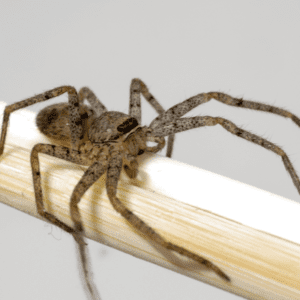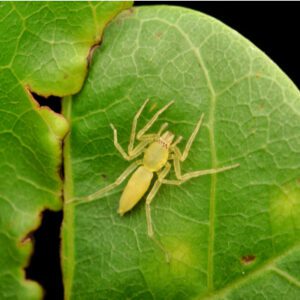You see them everywhere. They are white, and sometimes you will see the yellow, clear, glassy web of strings glistening in the sun. Spider webs and the creatures that design them are quite fascinating. Spiders, believe it or not, are actually good for controlling mosquitoes and the overall insect population. Sometimes, however, spiders can be downright scary, either by the way they look, their intrusive manner, or their venomous bite. There are over 620 species of spiders in Ohio. In this article, we discuss the five scariest, including the two deadliest. What better time than right before Halloween? As you put up your Halloween decor this season, be on the lookout for these five.
Black Widow
Probably the scariest of all is the Black Widow. Why? The black widow is well-known for the female’s red, hourglass-shaped mark on her abdomen. Movies and characters have been created based on this deadly creature. The bite of a black widow is highly dangerous. Its venom is 15 more times potent than that of a rattlesnake. But never fear. It is not common to see one, and black widows will only bite humans if threatened. They spin messy webs to capture mostly flies, grasshoppers, beetles, caterpillars, and mosquitoes. They have bristles on their hind legs they use to cover their prey with silk once they have trapped it. The weirdest thing about a black widow spider? Watch out, men.  During the mating season, the black widow will kill and eat her male counterpart. If you are bitten by a black widow spider, you should seek medical attention immediately.
During the mating season, the black widow will kill and eat her male counterpart. If you are bitten by a black widow spider, you should seek medical attention immediately.
The Recluse Spider
The second creepiest spider on our list is the recluse. There are two types of recluse spiders in Ohio, the brown recluse and the Mediterranean recluse. Recluse spiders are pale brown to reddish-brown and have distinct, long, thin, widespread legs that enable them to move around in all directions. These ghoulish looking creatures have six eyes instead of the typical eight. The brown recluse is known for its identifiable black mark on its abdomen that looks like a violin. In the winter, they will hide in the darkest areas of your home, including the basement, attic, garage, in trash cans, and boxes. The recluse spider is not considered aggressive, but they will bite if they feel threatened, which most often occurs when they are found accidentally. The bite of a recluse spider can cause skin cells to die in the area surrounding the spider bite, known as necrosis. It can lead to infection, and in rare cases, death. If a recluse spider bites you, you should seek medical attention immediately.
Jumping Spider
Jumping spiders are known for the tremendous leaps they can make to pounce on their prey. They are usually small, about a half-inch in length, and have hairy legs. Unlike most spiders, they do not spin webs. Instead, they make tiny tents under leaves and bark. They actively hunt insects and other spiders during the day, sneaking up and prancing on their victims. They have an alien-like eye pattern with eight eyes in three rows. The front row has four eyes and one huge pair right in the middle that is significantly larger than the backset of eyes. When they invade homes, they are mostly found hopping along with ceilings and windowsills. The good news? As creepy as it might seem to watch a jumping spider leap into action, they are not harmful to humans or pets.
Wolf Spider
These furry creatures will scare the pants off of anyone! With its hairy physique, it is often mistaken for the tarantula, but unlike the tarantula, it is not dangerous. It is quite large, usually brown and black with grey coatings. Their eyes remind you of something from a comic book, with four small eyes on the bottom row and two larger eyes straight above. Instead of spinning a web to capture their prey, they hunt for their meal on the move, like wolves. They live in burrows and pounce on their game as it crawls past the opening. In the home, they are most likely to be found in basements, crawlspaces, and near doors and windows. While they will bite in self-defense, they are not known to be aggressive. Unlike the black widow and recluse, they are not deadly. 
Yellow Sac Spider
Last but not least, these pale yellow and cream-colored spiders are commonly found all over the United States. They account for more spider bites on humans than any other spider. They are small, just about five to ten millimeters in length, with a large abdomen that looks like a sac. The yellow sac spider is a night time feeder feeding on small insects and other spiders. Because of this, they mostly live outdoors. But when it gets cold outside, they will seek shelter inside. This is why they are most commonly seen at night crawling on walls and across ceilings. Bites most often occur when they feel threatened or trapped. The bites are usually harmless but can cause allergic reactions in some. Serious symptoms of a yellow sac spider bite include a rash, fever, muscle cramps, nausea, and ulceration around the bite.
Stop Spiders and Other Pests From Entering Your Ohio Home With Perimeter Pest Control by Turf Pro Plus Lawn Care
Spiders are fun to learn about, talk about, and use for scaring during Halloween. But let’s face it, most of us aren’t comfortable hanging out with them. That’s where the professionals come in. The folks at Turf Pro Plus Lawn Care offer an efficient and highly-effective perimeter pest control service. At Turf Pro Plus, we create a liquid barrier around your house that will stop spiders, ants, earwigs, centipedes, and other crawling insects from entering your home. Fill out our form online or call us at 513-545-6295.